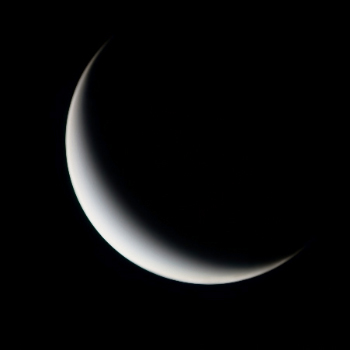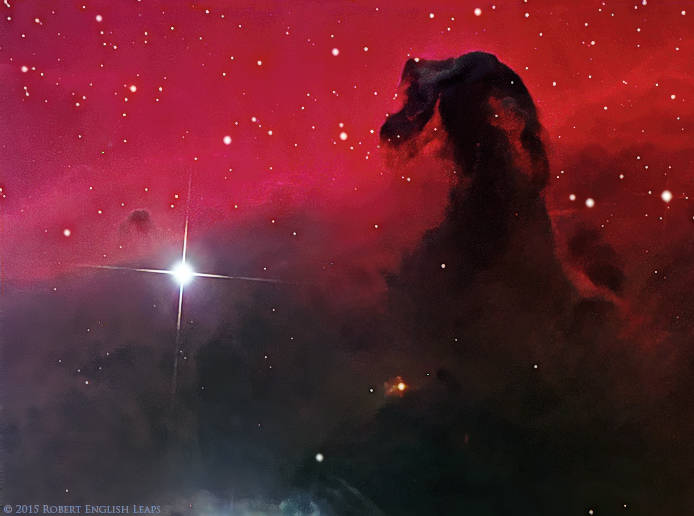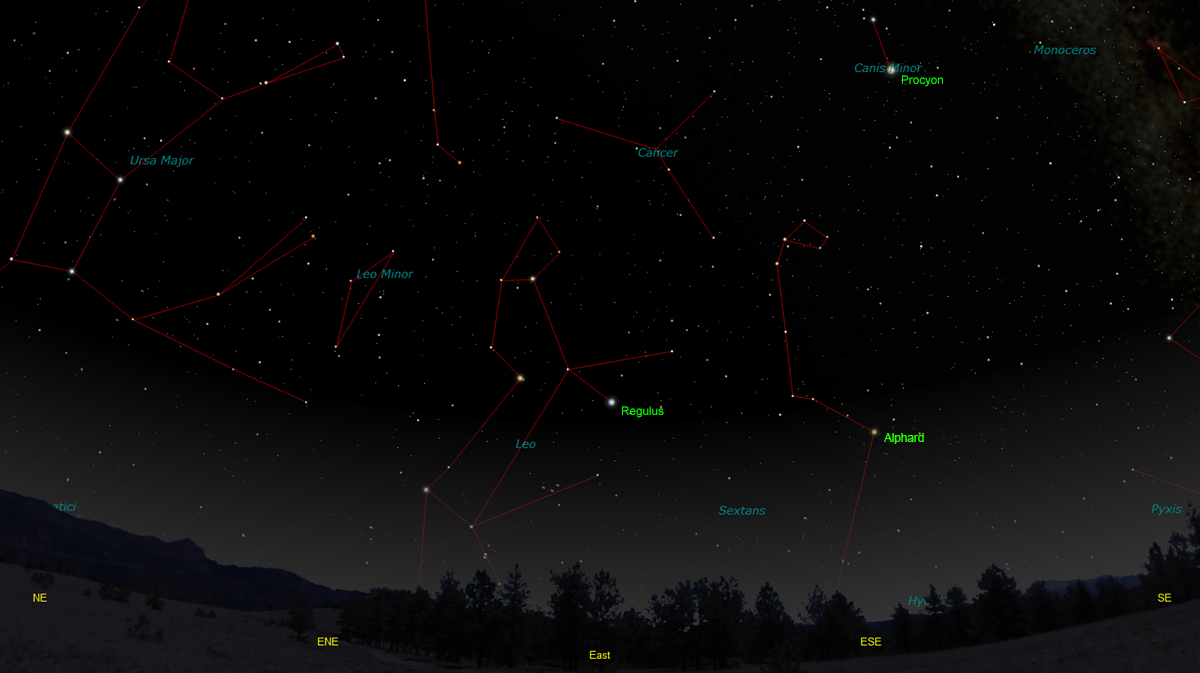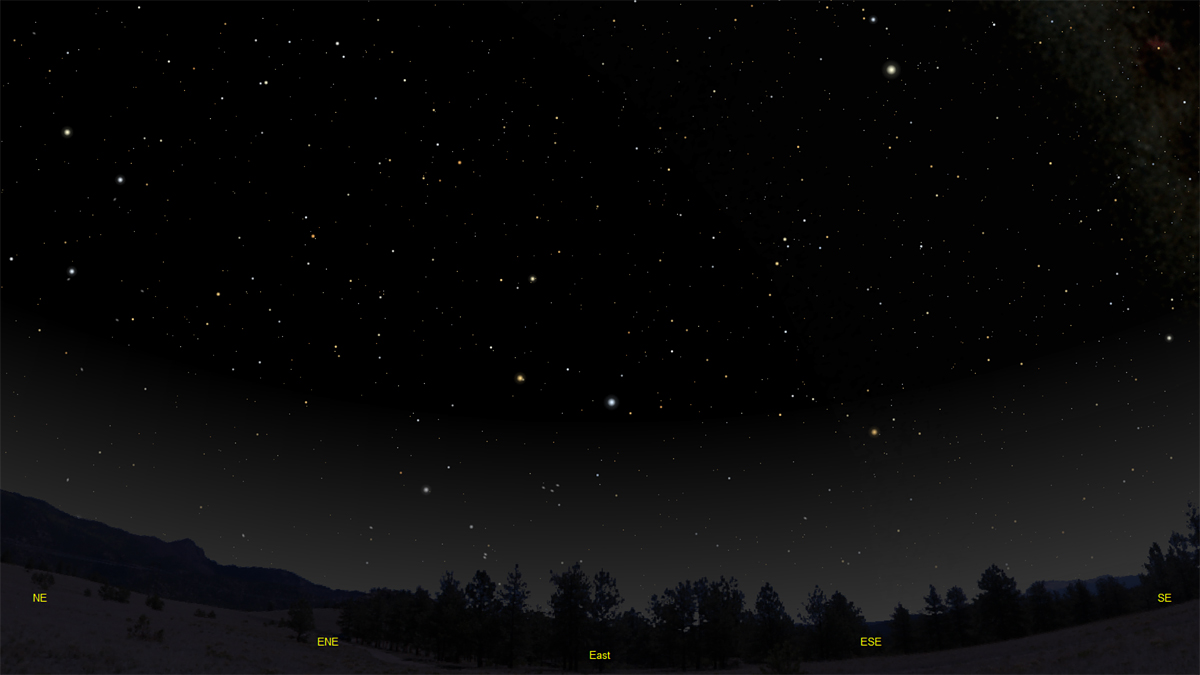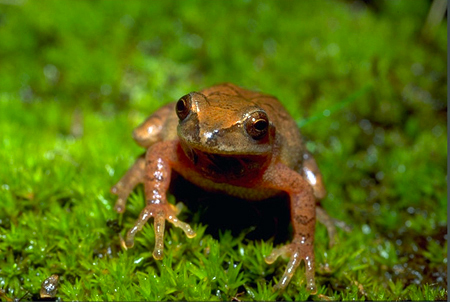The purpose of this feature is to give scout leaders, educators and naturalists an idea of some of the natural events coming up each month. We will try to cover a variety of natural events ranging from sky events to calling periods of amphibians, bird and mammal watching tips, prominent wildflowers and anything else that comes to mind. We will also note prominent constellations appearing over the eastern horizon at mid-evening each month for our area for those who would like to learn the constellations. If you have suggestions for other types of natural information you would like to see added to this calendar, let us know! Note: You can click on the hyperlinks to learn more about some of the featured items. To return to the Calendar, hit the "back" button on your browser, NOT the "back" button on the web page. All charts are available in a "printer friendly" mode, with black stars on a white background. Left clicking on each chart will take you to a printable black and white image. Please note that images on these pages are meant to be displayed at 100%. If your browser zooms into a higher magnification than that, the images may lose quality. Though we link book references to nationwide sources, we encourage you to support your local book store whenever possible.
Notes and Images From December 2018
The rains came without much letup in December. On many days clouds covered
the top of the Lookout Mountain. Cloudland,
where I am, lived up to its name. After such a brilliant fall, it was hard not to miss the
sunshine. The clouds and heavy fog gave the landscape an everchanging,
dreamlike quality. On December 9th I took a long walk in the misting rain
along the road in front of my house. The road winds through a habitat of
forests, agricultural lands and horse farms. Below are some images from
that walk. Welcome to
Cloudland.
Sky Events for January 2019:
The Quadrantid Meteor Shower peaks in the evening hours of January 3rd. The radiant is in the constellation of Bootes. The Earth reaches perihelion, its least distance to the Sun for the year, on January 3rd. This seeming paradox arises because the tilt of the Earth has much more effect on our temperatures than the relatively small variations in its distance from the Sun.
Morning Sky:
Mercury is visible for the first few days of this month. Look for it about 30 minutes before sunrise just above the southeast horizon. Jupiter rises higher into the morning sky each day this month. Look for it below and to the left of bright Venus in the southeastern sky 30 to 45 minutes before sunrise at the beginning of the month. It will appear to climb by Venus in the morning sky around January 26th. Saturn will move into the morning sky this month and will be visible low in the southeast by the third week of the month.
Evening Sky: Mars is in Pisces this month. By the end of the month it will appear only about 6 seconds of an arc in diameter. Times given are in EDT for Chattanooga. Those in other time zones will need to adjust the given times accordingly. Constellations: The views below show the sky looking east at 10:30pm EST on January 15th. The first view shows the sky with the constellations outlined and names depicted. Star and planet names are in green. Constellation names are in blue. The second view shows the same scene without labels.
Ursa Major , the Great Bear, has now cleared the horizon in the northeast. The bright stars of Leo, the Lion, are visible now. Hydra, the Water Serpent, rears its head menacingly. Hydra's brightest star Alphard is known as "The Solitary One" because of its somewhat isolated location from other bright stars. Canes Venatici, the Hunting Dogs, also makes its appearance just above the northeast horizon. Among the fainter constellations visible in the east are Leo Minor, the Small Lion, Cancer, the Crab, and Sextans, the Sextant. Look below Pollux and see if you can spot the faint glow of M44, the "Beehive Cluster." This cluster is located in Cancer, the Crab. To the south, the brilliant stars of Orion and Canis Major are dazzling. This is a great time to see the Orion Nebula, Messier 42, in a small telescope or binoculars. If you are in clear dark moonless skies and have a hydrogen beta nebula filter, it's a good time to search for the elusive Horsehead Nebula, located near the lowest star in Orion's belt. On Learning the Constellations: We advise learning a few constellations each month, and then following them through the seasons. Once you associate a particular constellation coming over the eastern horizon at a certain time of year, you may start thinking about it like an old friend, looking forward to its arrival each season. The stars in the evening scene above, for instance, will always be in the same place relative to the horizon at the same time and date each January. In particular, learn the brightest stars (like Regulus and Procyon in the above scene), for they will guide you to the fainter stars. Once you can locate the more prominent constellations, you can "branch out" to other constellations around them. It may take you a little while to get a sense of scale, to translate what you see on the computer screen or what you see on the page of a book to what you see in the sky. Look for patterns, like the stars of Leo. The earth's rotation causes the constellations to appear to move across the sky just as the sun and the moon appear to do. If you go outside earlier than the time shown on the charts, the constellations will be lower to the eastern horizon. If you observe later, they will have climbed higher. As each season progresses, the earth's motion around the sun causes the constellations to appear a little farther towards the west each night for any given time of night. If you want to see where the constellations in the above figures will be on February 15th at 10:30pm EST, you can stay up till 12:30am EST on the January 15th and get a preview. The westward motion of the constellations is equivalent to two hours per month. Recommended: Sky & Telescope's Pocket Star Atlas is beautiful, compact star atlas. A good book to learn the constellations is Patterns in the Sky, by Hewitt-White. You may also want to check out at H. A. Rey's classic, The Stars, A New Way to See Them. For sky watching tips, an inexpensive good guide is Secrets of Stargazing, by Becky Ramotowski.
A good general reference book on astronomy is the Peterson
Field Guide,
A Field Guide to the Stars and Planets, by Pasachoff. The book retails for around $14.00.
The Virtual Moon Atlas is a terrific way to learn the surface features of the Moon. And it's free software. You can download the Virtual Moon Atlas here. Apps: We really love the Sky Safari 6 Pro. It is available for both iOS and Android operating systems. There are three versions. The Pro is simply the best astronomy app we've ever seen. The description of the Pro version reads, "includes over 100 million stars, 3 million galaxies down to 18th magnitude, and 750,000 solar system objects; including every comet and asteroid ever discovered." A nother great app is the Photographer's Ephemeris. Great for finding sunrise, moonrise, sunset and moonset times and the precise place on the horizon that the event will occur. Invaluable not only for planning photographs, but also nice to plan an outing to watch the full moon rise. Available for both androids and iOS.
Amphibians:
This is also the time to look for Tiger Salamander and Streamside Salamander egg masses. Tiger Salamanders like to deposit their egg masses on the vegetation in shallow water in small ponds and wetlands. Streamside Salamanders deposit their egg masses on the bottoms of rocks in streams. If you are looking for salamanders, always remember to carefully replace any stones you pick up exactly where you found them. Recommended: The Frogs and Toads of North America, Lang Elliott, Houghton Mifflin Co.
Archives (Remember to use the back button on your browser, NOT the back button on the web page!) Natural Calendar December 2018 Natural Calendar November 2018 Natural Calendar February 2018 Natural Calendar December 2017 Natural Calendar November 2017 Natural Calendar October 2017Natural Calendar September 2017 Natural Calendar February 2017 Natural Calendar December 2016 Natural Calendar November 2016 Natural Calendar September 2016Natural Calendar February 2016 Natural Calendar December 2015 Natural Calendar November 2015 Natural Calendar September 2015 Natural Calendar November 2014 Natural Calendar September 2014 Natural Calendar September 2013 Natural Calendar December 2012 Natural Calendar November 2012 Natural Calendar September 2012 Natural Calendar February 2012 Natural Calendar December 2011 Natural Calendar November 2011 Natural Calendar September 2011 Natural Calendar December 2010 Natural Calendar November 2010 Natural Calendar September 2010 Natural Calendar February 2010 Natural Calendar December 2009 Natural Calendar November 2009 Natural Calendar September 2009 Natural Calendar February 2009 Natural Calendar December 2008 Natural Calendar November 2008 Natural Calendar September 2008 Natural Calendar February 2008 Natural Calendar December 2007 Natural Calendar November 2007 Natural Calendar September 2007 Natural Calendar February 2007 Natural Calendar December 2006 Natural Calendar November 2006 Natural Calendar September 2006 Natural Calendar February 2006
Natural Calendar December 2005
Natural Calendar November 2005
Natural Calendar September 2005
Natural Calendar February 2005
Natural Calendar December 2004
Natural Calendar November 2004
Natural Calendar September 2004
Natural Calendar February 2004
Natural Calendar December 2003
Natural Calendar November 2003 Natural Calendar February 2003 Natural Calendar December 2002 Natural Calendar November 2002 Nature Notes Archives: Nature Notes was a page we published in 2001 and 2002 containing our observations about everything from the northern lights display of November 2001 to frog and salamander egg masses. Night scenes prepared with The Sky Professional from Software Bisque All images and recordings © 2018 Leaps
|
|
rs800cr2.jpg)
